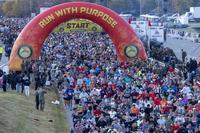In the world of Tactical Athletics, many mistakes are made by members of the military, police and firefighting communities on both ends of the fitness spectrum.
A few different segments within the community tend to mirror society’s issues. There are those who quit training after boot camp or police/fire academies and start to gain weight and get injured on the job. There are those who go hardcore every day with little to no recovery cycles. And there are those who find the right balance of workouts to help with job performance, mobility, recovery, longevity and, probably most important, stress mitigation.
With the latter being the optimal goal for the tactical athlete, here is a list of ways they are failing to meet that balance:
1. They go hard all the time. Even after a highly stressful day in the tactical professions, one thing you may not need is to beat your body up even more with high-intensity workouts. Instead, take a mobility day and do less intense non-impact cardio activity, mixed with stretching and foam rolling, for 45-50 minutes. Focus on big inhales into the nose and out of the mouth, keeping the heart rate moderately lower than typically hardcore workouts. See Stress Article for why this is important. There are days when high intensity interval training (HIIT)-type workouts are required and fine to do; some days should be just the opposite. Listen to your body.
2. Treat yourself like an athlete. The term “tactical athlete” is relatively new and has grown in popularity and understanding in the last decade. However, we as a community have not thought of ourselves as athletes for decades. But we are. The athleticism is different. You do not need to be world class in any element of fitness. In fact, it is better to be good at all the elements of fitness, vs. lacking in any of the following:
- Speed and endurance -- Run and ruck farther and faster.
- Strength and power -- Lift equipment, gear and people, too.
- Flexibility and mobility -- Move easily over uneven terrain and between obstacles.
- Muscle stamina -- Move yourself and gear up, over, under and through space.
- Old-man grip -- Hold gear, climb a rope or mountain, grab things and people without tiring.
- Skills -- Swim to save a life, cross a river and be effective on 75% of this planet.
- And more -- Anything and everything in your job.
3. Lack of recovery methods. You may call it overtraining or overstressed, but you also can refer to it as under-recovery. Sleep, nutrition, breathing and stretching can be basic methods to help you recover to nearly 100%, even after prolonged periods of high stress or overtraining. Do not forget that you can use a variety of gear to help your body recover from the pains of inflammation, overstress, and hard training or work days.
When you feel the candle being burned at both ends, it is time to pursue a recovery day actively and get extra sleep, eat well, hydrate, and add electrolytes, antioxidants, and other foods or supplements to help you fight the catabolic effects of stress.
4. Getting out of habit. Do not skip workouts. You can write off some days as a recovery day, but you cannot repeat that excuse day after day after day. If you do, you will be out of the habit of training and start to find yourself hurting more, sleeping worse, gaining weight and feeling weak.
At that point, you will have to force yourself into training again. It is better to stay in the habit of fitness (or get into it again) by plugging away daily, doing a variety of training methods that help you maintain or improve in all the elements of fitness above. Periodization is a great way to do this. See Tactical Periodization Method article.
5. Fitness challenges. Select moderate levels of fitness challenges to help you enhance your overall tactical fitness abilities. For instance, it is fine to do a cycle of heavy weight training, but do not get so into it that you lift heavy all year. That can jeopardize other elements of fitness, like muscle stamina and endurance, that you may need for the job.
Same for running or triathlons. These are great for a cycle or two in the year, but running hard and high miles month after month (or year after year) will yield injuries and expose a weakness in strength/power that you may need on the job. Consider what the job requires. It does not require world-class lifting, swimming or running records.
If you want a compromise, lift, run and do obstacle course races if you like to compete. There is nothing wrong with competing in athletic events; just be cautious not to let it affect the job, if possible.
Sometimes, “less is more” when it comes to training to stay in peak performance shape for the military, police and firefighting professions.
Stew Smith is a former Navy SEAL and fitness author certified as a Strength and Conditioning Specialist (CSCS) with the National Strength and Conditioning Association. Visit his Fitness eBook store if you’re looking to start a workout program to create a healthy lifestyle. Send your fitness questions to stew@stewsmith.com.
Want to Learn More About Military Life?
Whether you're thinking of joining the military, looking for fitness and basic training tips, or keeping up with military life and benefits, Military.com has you covered. Subscribe to Military.com to have military news, updates and resources delivered directly to your inbox.
















